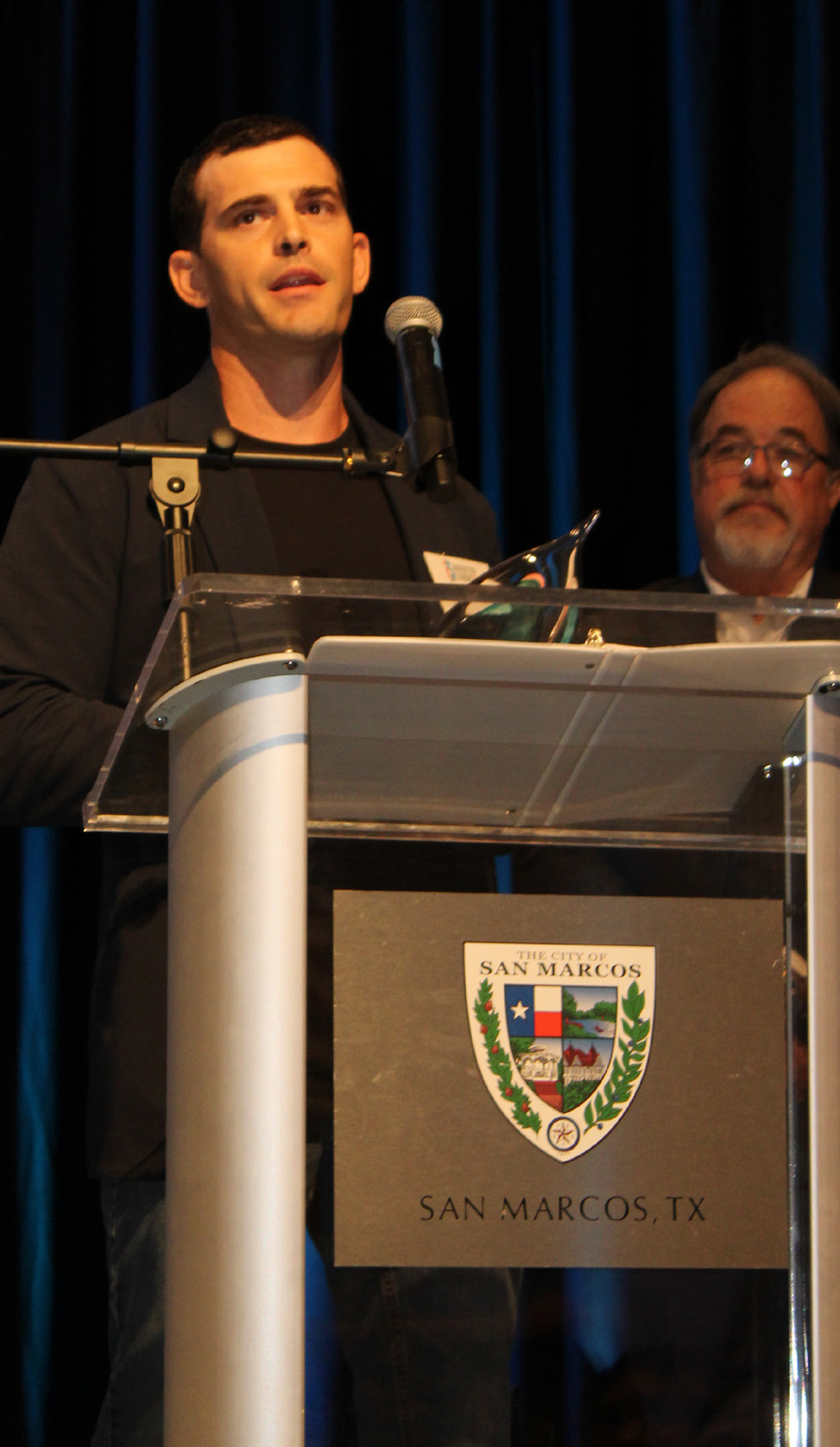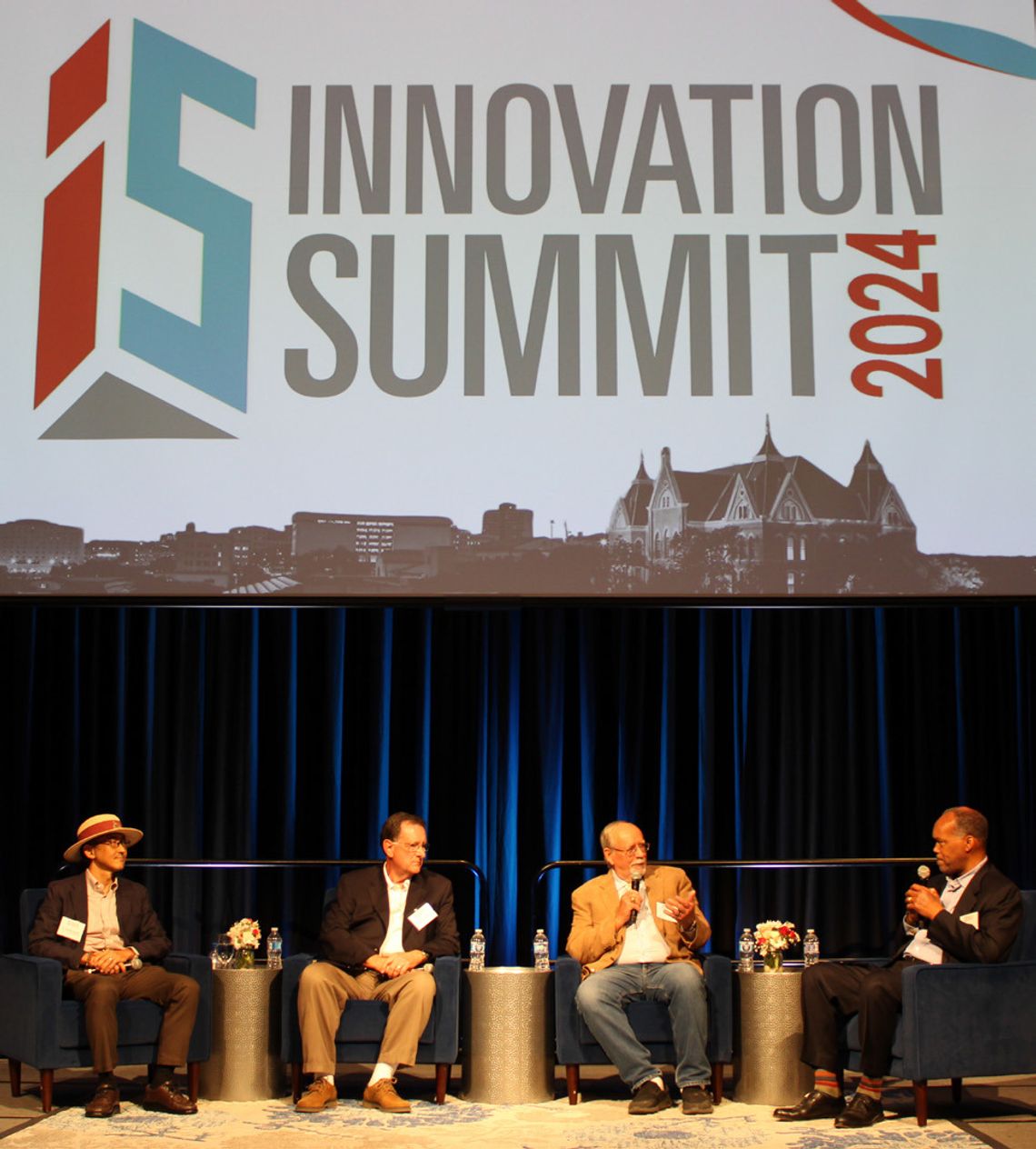GREATER SAN MARCOS PARTNERSHIP
Innovative business developments are occurring in the San Marcos area pushing the economy forward among other important aspects of the community. The Greater San Marcos Partnership hosted the tenth annual Innovation Summit last week to highlight three local engineers that are bringing new methods, ideas and products to their respective industries.
The keynote speaker and panel moderator for the event was Executive Director of Texas State Star Park Harold Strong. The highlighted businesses and innovators that participated in the panel are Gary Beall, Nabaco Inc. chief technology officer, Robert LeBlanc, Clever-Arium, LLC. chief executive officer and senior engineer, and Dr. Keisuke Ikehata, Texas State University Engineering assistant professor with a research focus on advanced water and wastewater treatment. Nabaco invented a product that increases fruit shelf life. Cleverarium invented an image tracking artificial intelligence application.
Ikehata, along with his research team of Texas State University students, has created a way to further treat wastewater, compared to its current process, for reuse.
PRESERVING FRUIT The discovery made by Nabaco, Inc. is a coating that allows fruits to have a longer shelf life and can be rinsed away along with any residual pesticides. The product is currently being used on pears, apples, cherries, oranges, lemons. The company is “moving into” using the product on avocados and melons, and Beall said he hasn’t found a fruit that it doesn’t work on.
“The product is called Natuwrap. It’s FDA approved for human consumption,” Beall said. “We’ve invented a natural clay and a natural polymer that’s extracted from trees… When we make that combination, it combines into an almost brick wall that protects the fruit from oxygen getting in and oxidizing it and water getting out. It’s based on a discovery that we made in our research lab at Texas State, and that was a very consequential discovery that nobody had ever seen before. It takes a specific type of polymer and a specific type of clay to get this to happen.”
Beall explained the process of coating the fruits.
“When the fruit is harvested, it’s taken into what are called sheds where the fruit is sorted, any calls are taken out, it’s sized and then packaged for the retailer,” Beall said. “We have what are called brush beds where the fruit goes across these rolling brushes, and we have a spray gun that sprays our coating onto the fruit and it gets brushed onto the fruit.”
Beall said Natuwrap is not widely distributed because the food business and the produce business are very conservative, so they won’t adopt new technology too quickly.
“Because the implications, if they have a recall, can be devastating,” Beall said. “So here in San Marcos we’re doing the R&D [research and development] to support new products but also the existing products. We’re also doing fundamental research on new products that we’ll be introducing in the future. We’ve been able to grow here very well because all of the resources that exist in the corridor — Austin to San Antonio, including San Marcos and Kyle. All of our customers are actually in California, Washington state and Spain.”
IMAGE TRACKING SOFTWARE Cleverarium is a hightech solution originally built for aquariums, but it has applications to other industries and technologies as well.
“It’s all about reducing the cost of doing business and giving you hightech capabilities with artificial intelligence. Generally speaking, this product works through a targeting process,” LeBlanc said. “We train the software to look for a certain image, and that image type in this case happens to be a fish, but it could be anything. It could be bacteria. It could be you. It could be your dog. It could be anything. Given enough information about the object, it can make decisions about the object.”
Leblanc said the product has no limits to its use just like artificial intelligence in general.
“It is an image tracking application, which has very, very widespread applicability,” LeBlanc said. “It’s applicable to any industry that has any component, any aspect that it needs monitored visually through imaging applications. What it offers is the ability to quickly train the artificial intelligence.”
He gave the example of how it could be used on a cattle ranch.
“Here in Texas, we’re cattle country, and that’s a lot of work. It takes a lot of labor. It takes a lot of time, and you want to be able to make decisions faster with ease, maybe requiring less people involved with it,” LeBlanc said. “You want to get your cattle to market faster. You want to make sure that momma’s pregnancy is progressing properly, but you don’t want to ride out every day to check on her. You could use artificial intelligence and imaging, for example, to monitor it.”
San Marcos was chosen as the home of Cleverarium for several reasons, including the fact that Texas State University has a research level aquaculture facility.
“They’ve been integral in helping us build the components of our business,” LeBlanc said. “Central Texas, particularly the Austin area including San Marcos, has become very well known for its acumen in software development and technology, engineering, and we’re part of that community.”
WASTEWATER TREATMENT RESEARCH
Ikehata said his research at TXST will solve a dire need for additional water. “Central Texas is running out of water, and we need to find another source of water to sustain the economic growth and people coming to Texas from elsewhere,” Ikehata said. “Right now, the city of San Marcos is receiving eight to ten million gallons wastewater from all over the city, including Texas State, and then they treat the wastewater through several processes, including biological treatment, anthracite filtration and UV disinfection. Once the water is treated, the majority of wastewater is currently discharged into the San Marcos River.”
Ikehata’s team is proposing the implementation of Direct Potable Water Reuse. It involves taking treated wastewater that is safe enough to be discharged into the river, purifying it further and sending it back to the city.
“So that we can protect our water resources. This has not been used because people have a negative feeling toward the wastewater based on where it is coming from — toilets, showers, kitchens and so on,” Ikehata said. “We’d like to remove those barriers by proving these processes are working perfectly, and the water we are producing is crystal clear and pleasant to drink.”
Ikehata explained the purification process used.
“This process is taking the water from the city of San Marcos treatment plant, at the very end of it, and we inject different types of chemicals. And [the water is] going through different types of membrane filtrations, and at the end, we will have the very pure water that is drinkable,” Ikehata said. “We will reduce the amount of groundwater we draw from Edwards Aquifer, and also we will create new water for people coming to Central Texas, specifically the city of San Marcos.”
He believes this discovery is huge for the economic development of this region.
“Right now there is a scarcity of clean drinking water,” Ikehata said. “I feel this project is worthy because we can make everybody happy. Everybody wins — society and the environment. I believe this student-driven research project is the only one of its kind in this country. There are students from Texas State who are a big part of this project; They are operating the system [and] testing the water every day. Without them, this project cannot be possible.”




